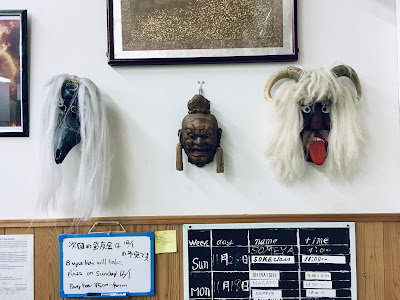 |
| Bujinkan Honbu Masks, photo from same day by Michael Glenn |
Tonight in my class we studied 夢落 yume otoshi. The last time I did this in Japan, Hatsumi Sensei gave us some insights that I want to share with you. He began by telling us 空間で嚮導 Kūkan de kyōdō, or lead the opponent in the kukan.
That was when I should have changed into a new gi. Because it was like a new life for an old ninja. I had a breakthrough for my understanding of taijutsu. But my day leading up to that experience gave no warning it would be special.
I trained for about 6 weeks in Japan every year. So not every day could be amazing. This particular Friday was cold, wet, and boring. I had only errands to keep me entertained before Hatsumi Sensei’s class.
Even my lunch was uninspired. I hunkered down at the low budget family restaurant, Saizeriya in Nagareyama. I only wanted to get out of the cold rain for a bit and work on my training notes in a quiet booth.
Christmas music was already playing, but the holiday decor was only half done. There was a lone Christmas tree surrounded by traffic cones for some arcane reason known only to the カラーコーン fairies. I watched a broken, discarded umbrella blow across the plaza and crash into the soggy tree.
Lucky for me Soke had changed the start time of his classes to 6pm. His 米寿 beiju (88th birthday) was in a couple of weeks. And preparations were underway for his party.
It took almost his entire class to clear my head. I was training with an XXL guy from Finland and he didn’t allow any technique to be done easy. I was beginning to feel like that broken umbrella at the train station.
Then, Hatsumi Sensei showed how to do the 大外掛 Ōsoto gake from yume otoshi. It was only a couple of minutes until the end of training. But he made some wonderful points:
- First, he said our foot placement was too wide. We should only allow enough space for the knee to come through.
- Second, Get the 姿勢 shisei, or posture right by expanding the chest and keeping the head up.
- And Third,「頭の向きは投げる方向」Where you look is where you will throw. But the ura side of this is getting the opponent to look in a direction so he throws himself!
Then Soke told us,
空間で嚮導 Kūkan de kyōdō, lead the opponent in the kukan. You must study something beyond waza, beyond technique. Transcend waza. Without avoiding you move like this. Step slowly, then hold it like this. Let’s try that… that will be the end.Now here I am two years later sharing these same tips with my students. I do my best to remember the feeling from Soke that night. I would like to take them in a time machine so we could all eat lunch at the Saizeriya and go to Hatsumi Sensei’s class together. But time travel is only in my head training with my memories.
Comments
Post a Comment